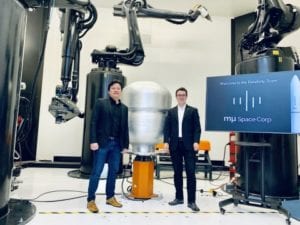
Relativity, the world’s first autonomous rocket factory and launch services leader for satellite constellations, announced on 23 April 2019 a partnership with mu Space, the innovative Thai satellite and space technology company, to launch a satellite to Low Earth Orbit (LEO) on Relativity’s Terran 1 rocket, the world’s first and only 3D printed rocket.
Relativity’s groundbreaking, patented 3D printing technology platform together with Terran 1’s unique and flexible architecture provides mu Space a faster and more reliable launch at a lower total mission cost than any other launch services company in the world. With this launch partnership, two of the most visionary and innovative aerospace startups are sharing expertise, resources, and capabilities to transform the satellite launch and services industry across the U.S. and Asia-Pacific regions.
Relativity is developing the first and only aerospace platform to integrate machine learning, software, and robotics with metal 3D printing technology to build and launch rockets in days instead of years, disrupting 60 years of global aerospace manufacturing. The company expects to build its Terran 1 rocket from raw material to launch-ready in less than 60 days. As an innovator in the Asia-Pacific and international arenas, mu Space is developing both Low Earth Orbit (LEO) and Geosynchronous Earth Orbit (GEO) satellite and space technologies that will accelerate the adoption of Internet of Things (IoT) devices in smart cities, and encourage new space investments in the Asia-Pacific region. mu Space’s LEO satellite will be a primary, dedicated payload on Relativity’s Terran 1 rocket, launching in 2022.
This partnership also progresses a long-term opportunity and shared vision toward building the future of humanity in space. Relativity plans to 3D print the first rocket on Mars and build an interplanetary society to expand the human experience. mu Space has a goal of developing space technologies to ensure safer lunar missions and to enable human settlement on the moon within the next 10 years.
“mu Space is accelerating space technology development in Asia, and we consider the moon as the next explorable body in space beyond Earth,” said James Yenbamroong, CEO and founder of mu Space. “Relativity has the vision, team, and technology to deliver exceptional advantages in launching mu Space’s payloads, and supporting our goal of creating an interplanetary society in the future.”
“We’re excited to partner with mu Space, a disruptive innovator in the Asia-Pacific region, to launch their satellite and space technologies with our 3D printed Terran 1 rocket,” said Tim Ellis, CEO and cofounder of Relativity. “We look forward to collaborating to strengthen the U.S. and Asia-Pacific space economy, and to advancing the future of humanity in space together with James and the entire mu Space team.”
Earlier this month, Relativity announced a multi-launch contract with Telesat, the renowned satellite operator, to support Telesat’s LEO constellation. This was the first time Telesat, or any major global satellite operator, had selected a fully venture-backed aerospace startup for launch services. This partnership with mu Space further establishes Relativity’s emerging leadership in the global satellite launch services industry. The company is on track to conduct its first orbital test launch at the end of 2020, and continues to grow a customer manifest of leading global satellite operators, commercial companies, and government payloads.
Relativity recently became the first venture-backed company to secure a launch site Right of Entry at Cape Canaveral Launch Complex-16 from the U.S. Air Force, adding to its portfolio of major government partnerships including a 20-year exclusive-use Commercial Space Launch Act (CSLA) agreement at the NASA Stennis Space Center E4 test complex, and membership on the National Space Council advising the U.S. White House. The company is expanding its infrastructure this year with a fourfold expansion to over 350,000 square feet of operations, production, testing, and launch facilities, including securing a polar orbit capable launch site. Relativity’s team has grown 6x in the past year, from 14 to 83 employees.





